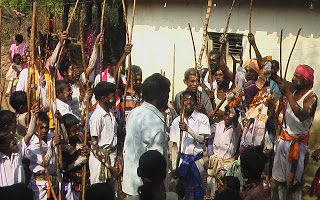Banabadi is a traditional dance of Gour caste in Kalahandi district. It is performed with two players in a competitive manner and also played with a group of eight to ten. 32 sanghad or techniques are used in this dance form.
The sticks used by the dancers are made up of log of kendu (tendu) wood. First the upper crust of the stick is removed and polished then a kind of grass cord (laha /latta) is wind up in a crafty manner with a definite gap on the sticks. Then it is lightly burnt by the straw of rice and the cords unwind. The burnt part turns into black colour while the rest remains white, making a lovely design on the sticks. The sticks look as if tattooed with black and white. Tattoo is locally known as Bana so the dance is called Banabadi Dance. A dancer uses two such sticks while dancing.
Baensi, dhol, jhumka etc. are some instruments used by the dancers. The dancers make tattoo with rice pest (pithau) on their body.
This dance is seen after some days of Deepawali, during the festival of Kanha Bhairo, the presiding deity of Gour caste. Few lines which sung during this dance are:
“Kanha bhai lachmi ghena mo dayini
Jayama jadavakula maudamani
Jaye chandi samalai maa thakurani
Sankata tarini maa durgati nasini
Bipade aapade maago heu agrani
Jaya maa jadavakula maudamani”
This dance form resembles to a duel. The two dancers hold the sticks in their two hands and attack and defense themselves from their counterpart. And the song goes as follows:
“Dwapar jugare prabhu nandanandana
Gopa gopalanka sange mela hoina
Bajai range dhola tamaka bansuri
Shirare paga bandhi kendubadi dhari
Karuthile e tandaba dharma lekhani
Jaya maa jadavakula maudamani”
The history of the caste is related with the dance. There is startling citation of Banabadi in Haribansa Puran. Banabadi song provides information regarding the 16 types of Gour caste which is referred in Haribansa Puran:
“Bhojpuri, Goppuri, Shoal khandia
Magadha, Gokul, Lahoria, Jharia
Nanda, Dravida, Jachaka, Duta, Koria
Ahir, Abada, Asak, Kosalia
Ae shoal jadavakula maa patarani
Jaya maa jadavakula maudamani”
An instance of Banabadi is also cited in Birat Parba of Mahabharat. During the Agyantbasa period of Pandavas, Sahadev was the caretaker of the cattle of Virat king and while he was trying to dispose those cattle king Virat rescued with Banabadi. Apart from this, citations are also found in Chittabodha, Nrusingha Puran etc.
This dance form is found in almost all parts of Kalahandi, whereas the affluent areas are Koksara, Junagarh, Dharmagarh, Madanpur Rampur, Bhawanipatna and Jaipatna.

